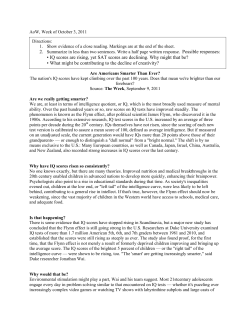
A FAMILY GUIDE - Be a Learning Hero
A FAMILY GUIDE TO YOUR STATE’S NEW ANNUAL TESTS: SMARTER BALANCED SCHOLASTIC and associated logos are trademarks and/or registered trademarks of Scholastic Inc. All rights reserved. 643497 Photo: © Kidstock/Media Bakery. With Generous Support From Flip this booklet over for a Spanish language version of this guide. Why do we have new tests? ◆ How are the new tests different? ◆ What do the Smarter Balanced tests look like? What is Smarter Balanced? ◆ When will I receive the test scores? ◆ What will the test scores mean for my child? How can these tests help my child's teacher? ◆ What resources are available to help my child? INSIDE: A Family Guide to Your State’s New Annual Tests: Smarter Balanced Why do we have new tests? Your state has adopted a set of new academic standards that focus on the criticalthinking, problem-solving, and reasoning skills students need in today’s world. Known as the Common Core State Standards, they describe the skills and knowledge students should know at every grade level in ELA and math. These new standards require new tests to match the skills being taught in the classroom. These tests serve as an academic checkup, helping teachers and parents know how well students are progressing and if they are ready for the next step. The tests are designed to replace the previous statewide tests in ELA and math. How are the new tests different? They are “computer adaptive.” The tests are personalized and adjust to a student’s learning level by giving harder or easier questions based on how well he or she is doing. The goal is to be more interactive and less frustrating for students because they are challenged throughout the test. It also provides more accurate results, especially for advanced and struggling students. They These new tests focus more on applying skills than rote memorization. allow students to show their work. On the Smarter Balanced tests students are required to show their work and explain their reasoning so teachers can better understand what they know and where there are gaps that need to be addressed. They contain a performance task that mirrors classroom work. Along with the computeradaptive test, students also complete a performance task. This is a multistep assignment that asks students to apply their knowledge and skills to address real-world problems. In ELA, students have to apply their research and writing skills, and in math, they will solve a complex problem and then describe and defend their reasoning. measure critical thinking, and therefore take longer to complete. Students will be asked to read and analyze complex text and then write well-thought-out responses, which takes more time than multiple-choice. • Last spring, Smarter Balanced ran a field test with more than 4 million students. Based on results from the field test, students will typically take 7 to 8½ hours to complete both sections of the ELA and math tests. The tests are untimed so that students can work at their own pace. Students will typically test for one to two hours per day, depending on their grade level. Reading at Home to be mutually exclusive. Build your Read aloud to your child above his child’s curiosity and explore new topics. or her own reading level. It is so important for building knowledge Keep books at home and encourage and vocabulary. Select books that your child to read independently. build on your child’s interests. Have discussions at dinner about what they read and make connections Choose a balance of fiction and throughout the day to the topics in nonfiction. Pleasure reading and the books they have chosen to read. reading for information don’t have Photo: © GM Visuals/Media Bakery. They hey provide information about students' strengths and weaknesses. Parents and teachers T will receive a score report, including a breakdown of students’ performance in subsets of skills within each subject. For example, the ELA report will show how well students performed in reading, writing, listening, and research. The reports can be used by parents and teachers to figure out where students are on their continuum of learning. Some students may need a little more support and other students may need to be challenged by going deeper into a subject. They challenge students. With a greater emphasis on deeper learning, there is no doubt that schools are expecting more from students, teachers, and parents. Lower test scores do not mean students are performing worse or that they are learning less. It means the tests have changed and are measuring different things—such as how well students are mastering the skills they need to be ready for the next step. They do not lend themselves to “teaching to the test.” The new tests focus more on applying skills than rote memorization, so they capture more information on how well students can comprehend what they have learned, reason, and justify an answer. It is the daily practice of these skills in the classroom that will serve as the best preparation for this test. They can be taken by most students. These tests contain features and tools for students with special needs and those learning English. The resources, including glossaries in multiple languages, videos of sign language interpreters, and Braille, make it CONT. ON NEXT PAGE possible for most students to access and answer test questions. What do the Smarter Balanced test questions look like? Previous Fifth-Grade Math Question: Which number makes the equation true? 4 A. B. 3 x __ = 4 3 __ 16 12 __ 16 C. 3 D. 4 Previous Seventh-Grade ELA Question: Your principal is considering requiring assigned seats in every classroom. Do you think students should have assigned seats in every class? Take a position on this issue. Write a multipleparagraph letter to persuade your principal to support your position. Smarter Balanced Fifth-Grade Math Question: Drag one number into each box to create a fraction that correctly completes each statement. 0 1 2 3 4 5 6 7 8 9 4x <4 4x =4 4x >4 Smarter Balanced Seventh-Grade ELA Question: You have read several sources about the production of pennies in the United States. Using your sources, write a multiple-paragraph argumentative essay either for or against the continued production of the penny in the United States. Make sure you establish a claim, address counterarguments, and support your claim with evidence from the sources you have read. Develop your ideas clearly and use your own words, except when quoting directly from the sources. Be sure to reference the sources by title or number when using details or facts directly from the sources. A Family Guide to Your State’s New Annual Tests: Smarter Balanced CONT. FROM PREV. PAGE What is Smarter Balanced? The Smarter Balanced Assessment Consortium is a group of states that brought educators and other experts together to develop tests aligned to the Common Core State Standards. The states and educators developed new tests with the goal of providing a deeper level of information to teachers and parents to support student learning. When will I receive the test scores? In most states, parents will receive score reports during the summer. Achievement levels, the categories of performance that allow parents and teachers to understand how completely a student has mastered the standards in every grade, were set using the field tests from 2014. They will be verified after the first round of tests to make sure they are appropriate. What will the test scores mean for my child? The scores will identify where students need extra support and where they excel. These test scores do not impact a student’s GPA or college acceptance. The first year of scores will identify the areas where students need extra support and where they excel. They will serve as a new baseline so that progress can be measured from this year forward. After this transition year, scores will be used to personalize learning as well as measure how well schools, districts, and states are doing against the higher standards. In some states, public colleges and universities may use the grade 11 test score to help determine whether first-year students can begin taking credit-bearing courses. How can these tests help my child's teacher? Teachers need to understand how well students are mastering challenging skills and where there are gaps, so the tests can help inform instruction. ◆ Resources to Help Your Child Smarter Balanced: Provides a wealth of information from practice tests to directions on how to navigate the test and use the features. www.smarterbalanced.org Great Schools Videos: Watch grade-level and content-specific videos of learning in action. www.greatschools.org/gk/milestones Common Sense Media: Contains apps and games aligned to the ELA and math standards for students at different grade levels. www.commonsensemedia.org Photo: © Molly Flanagan/Shutterstock. Be a Learning Hero: Contains helpful tips to support your child in ELA and math at home, as well as links to great resources. www.bealearninghero.org
© Copyright 2025

















